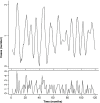Nontuberculous Mycobacterial Disease in Children - Epidemiology, Diagnosis & Management at a Tertiary Center
- PMID: 26812154
- PMCID: PMC4727903
- DOI: 10.1371/journal.pone.0147513
Nontuberculous Mycobacterial Disease in Children - Epidemiology, Diagnosis & Management at a Tertiary Center
Abstract
Background: There are limited data on the epidemiology, diagnosis and optimal management of nontuberculous mycobacterial (NTM) disease in children.
Methods: Retrospective cohort study of NTM cases over a 10-year-period at a tertiary referral hospital in Australia.
Results: A total of 140 children with NTM disease, including 107 with lymphadenitis and 25 with skin and soft tissue infections (SSTIs), were identified. The estimated incidence of NTM disease was 0.6-1.6 cases / 100,000 children / year; no increasing trend was observed over the study period. Temporal analyses revealed a seasonal incidence cycle around 12 months, with peaks in late winter/spring and troughs in autumn. Mycobacterium-avium-complex accounted for most cases (77.8%), followed by Mycobacterium ulcerans (14.4%) and Mycobacterium marinum (3.3%). Polymerase chain reaction testing had higher sensitivity than culture and microscopy for acid-fast bacilli (92.0%, 67.2% and 35.7%, respectively). The majority of lymphadenitis cases underwent surgical excision (97.2%); multiple recurrences in this group were less common in cases treated with clarithromycin and rifampicin compared with clarithromycin alone or no anti-mycobacterial drugs (0% versus 7.1%; OR:0.73). SSTI recurrences were also less common in cases treated with two anti-mycobacterial drugs compared with one or none (10.5% versus 33.3%; OR:0.23).
Conclusions: There was seasonal variation in the incidence of NTM disease, analogous to recently published observations in tuberculosis, which have been linked to seasonal variation in vitamin D. Our finding that anti-mycobacterial combination therapy was associated with a reduced risk of recurrences in patients with NTM lymphadenitis or SSTI requires further confirmation in prospective trials.
Conflict of interest statement
Figures



References
-
- Tebruegge M, Curtis N (2012) Mycobacterium species non-tuberculosis In: Long S, Pickering L, Prober C, editors. Principles and Practice of Pediatric Infectious Diseases. 4th Edition Philadelphia, US: Saunders/Elsevier; pp. 786–798.
-
- Horsburgh CR Jr, Selik RM (1989) The epidemiology of disseminated nontuberculous mycobacterial infection in the acquired immunodeficiency syndrome (AIDS). Am Rev Respir Dis 139: 4–7. - PubMed
-
- Romanus V, Hallander HO, Wahlen P, Olinder-Nielsen AM, Magnusson PH, Juhlin I (1995) Atypical mycobacteria in extrapulmonary disease among children. Incidence in Sweden from 1969 to 1990, related to changing BCG-vaccination coverage. Tuber Lung Dis 76: 300–310. - PubMed
-
- Wolinsky E (1979) Nontuberculous mycobacteria and associated diseases. Am Rev Respir Dis 119: 107–159. - PubMed
Publication types
MeSH terms
Substances
LinkOut - more resources
Full Text Sources
Other Literature Sources
Medical

